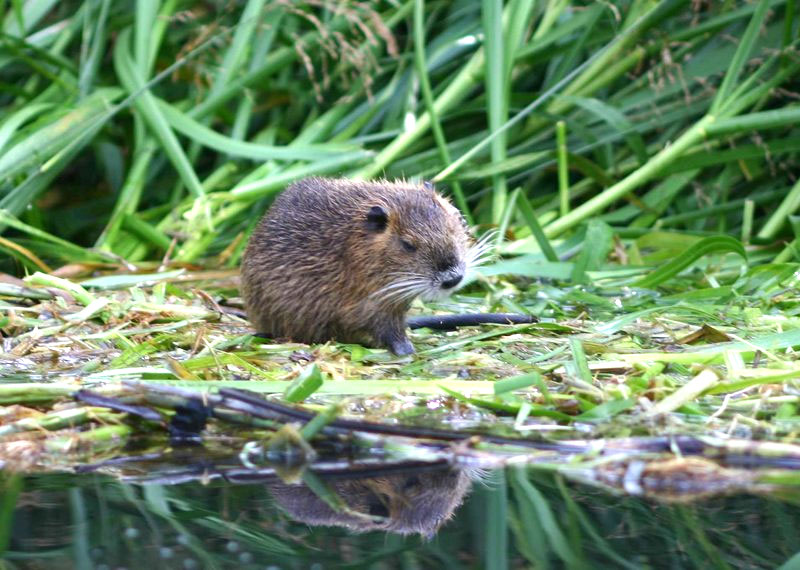Nutria (Myocastor coypus) - Wiki Coypu
From Wikipedia, the free encyclopedia
[Photo] Deutsch: Myocastor coypus (Biberratte) in Lehde, Spreewald (Germany) Photographed by Mike Kr??ger, http://commons.wikimedia.org/wiki/User:MikeKrueger
The coypu or nutria (Myocastor coypus) is a large, crepuscular, semiaquatic rodent native to South America, but now also present in Europe, Asia, Africa, and North America. In most regions the coypu is considered a pest. In eastern Europe and Central Asia, however, it is still valued for its fur. It is the only species in the genus Myocastor and is sometimes given its own family: Myocastoridae. The coypu, an herbivore, has been introduced from South America to every continent except Australia and Antarctica. The animal is adapted to subtropical and mild temperate climates.
There are two common names used in the English language for Myocastor coypus. Coypus originated from the Amerindian Mapudungun language word coypu or k??ypu and was adopted by American Spanish as Coipo is generally used in Europe and Latin America. This avoids confusion with the term "nutria," which is Spanish for carnivores commonly called otters (Lutra sp.) in British and American English. In North America and Asia the term nutria is the more commonly used one for Myocastor coypus.
Appearance
The coypu somewhat resembles a very large rat in appearance. Adults are typically 5???9 kg (10-20 lbs) in weight, and 40???60 cm (15-24 inches) in body length, with a 30???45 cm (12-18 inches) tail. They can also be identified by their bright orange-yellow incisor teeth (unlike rats, which have brownish yellow incisors). The nipples of female coypu are on her back. This allows their young to feed while the female is in the water.
Coypu can also be mistaken for another widely dispersed semi-aquatic rodent that occupies the same wetland habitats, the muskrat. The muskrat, however, is smaller, more tolerant of cold climates, and has a dorso/ventrally flattened tail that it uses to assist in swimming, whereas the tail of a coypu is round.
Subspecies
There are several subspecies of coypu in their native range which includes parts of Argentina, Bolivia, Brazil, Chile, Paraguay and Uruguay. While as many as six different subspecies have been named generally there are only four recognized. They are: Myocastor coypus coypus, M. coypus bonarieusis, M. coypus melanups, and M. coypus santacruzae. Most literature indicates the coypu subspecies introduced around the world was M. coypus bonariensis. This subspecies is from the more northern (subtropical) part of their range.
Commercial and environmental issues
Local extinction in their native range due to overharvest led to the development of coypu fur farms in the late 1800s and early 1900s. The first farms were in Argentina and then later in Europe, North America, and Asia. These farms have generally not been successful long term investments and farmed coypu often are released or escape as operations become unprofitable.
As demand for coypu fur declined, coypu have since become pests in many areas, destroying aquatic vegetation, irrigation systems, chewing through human made items, such as tires and wooden house panelling in Louisiana, eroding river banks, and displacing native animals. Coypu were introduced to Louisiana in the 1930s for fur, for example, and nutria damage in Louisiana became so severe that in 2005, a bounty program was in effect to aid in controlling the animal. In the Chesapeake Bay region in Maryland, where they were introduced in the 1940s, coypu are believed to have destroyed 7,000 to 8,000 acres of marshland in the Blackwater National Wildlife Refuge. In response, by 2003, a multi-million dollar eradication program was underway.
Coypu were also introduced to East Anglia, again for fur, in 1929; many escaped and damaged the drainage works, and a concerted programme by MAFF eradicated them by 1989.
Coypu meat is lean and low in cholesterol. While there have been many attempts to establish markets for coypu meat, all documented cases have generally been unsuccessful. Unscrupulous entrepreneurs have promoted coypu and coypu farms for their value as 'meat', 'fur', or 'aquatic weed control.' In recent years they have done so in countries such as the United States, China, Taiwan and Thailand. In every documented case the entrepreneurs sell coypu "breeding stock" at very high prices. Would-be coypu farmers find that the markets for their products disappear after the promoter has dropped out of the picture.
In addition to direct environmental damage, coypu are the host for a nematode parasite (Strongyloides myopotami) that can infect the skin of humans. When this happens the condition is called "nutria itch."
Distribution
The distribution of coypu tends to expand and contract with successive cold or mild winters. During cold winters, coypu often suffer frostbite on their tails leading to infection or death. Populations of coypu under these circumstances often contract and even become locally or regionally extinct (as in the Scandinavian countries during the 1980s). During mild winters, their ranges tend to expand northward.
http://en.wikipedia.org/wiki/Coypu
| The text in this page is based on the copyrighted Wikipedia article shown in above URL. It is used under the GNU Free Documentation License. You may redistribute it, verbatim or modified, providing that you comply with the terms of the GFDL. |
